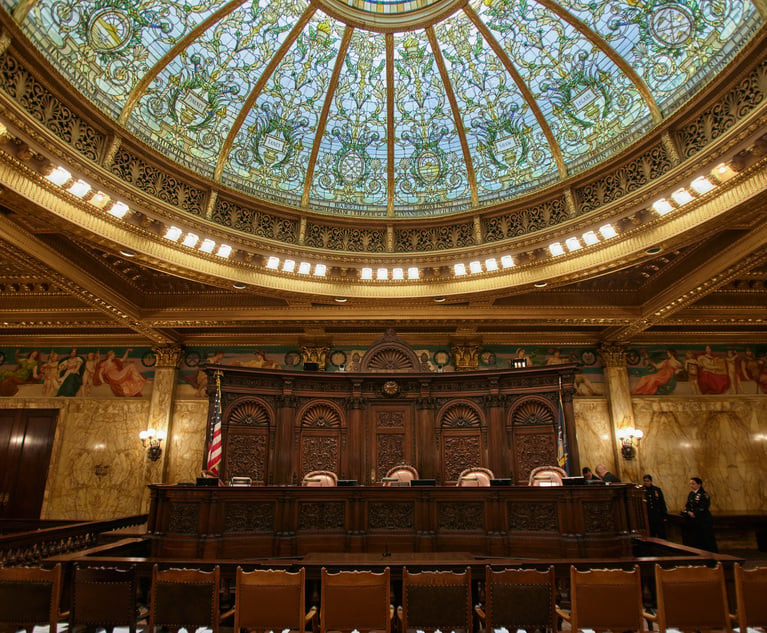New Legislation Implementing Police Reform in New York
In the wake of an historic wave of protests, sparked by the death of George Floyd, New York became one of the first states to enact an expansive package of police reform bills, in his Criminal Law and Procedure column Barry Kamins discusses these bills and how they will affect the police department.
August 03, 2020 at 11:37 AM
12 minute read
 Barry Kamins. Photo by Rick Kopstein
Barry Kamins. Photo by Rick KopsteinIn the wake of an historic wave of protests, sparked by the death of George Floyd, New York became one of the first states to enact an expansive package of police reform bills. In addition, the New York City Council enacted a series of laws that will have a significant impact on members of the New York City Police Department.
Among the series of laws enacted by the Legislature, the centerpiece was the repeal of Civil Rights Law 50-a (CRL 50-a), which had shielded from public disclosure, certain police records containing disciplinary actions and misconduct complaints. The statute was enacted in 1976 to prevent what was then perceived as efforts by defense counsel to utilize information contained in police personnel records to cross-examine and impeach officers during trial in an overly aggressive and unfair manner. Cf. People v. Gisendanner, 48 N.Y.2d 543 (1979).
Prior to the repeal of CRL 50-a, New York and Delaware were the only states that had provided statutory protection to police officer personnel records. With the repeal, New York has joined 12 other states in promoting transparency of police disciplinary procedures.
Under the new law (L. 2020, Ch. 96, eff. June 16, 2020), Section 50-a of the Civil Rights Law is repealed and, as a result, police personnel files are now to be treated in the same manner as other police records for the purpose of discovery. The new law did, however, amend the Public Officers Law to require certain limited information to be redacted when personnel files are disclosed.
Thus, before providing records, a law enforcement agency must redact certain personal information, including medical history, home address, personal phone numbers, email addresses, Social Security numbers, and the like. In addition, the agency can redact records pertaining to a "technical infraction." A technical infraction is defined as one that does not involve interaction with members of the public; is not of public concern; and is not otherwise connected to a police officer's investigative, enforcement or training responsibilities. Technical infractions might include uniform violations or untidy stationhouse lockers.
An argument can be made that, after the repeal of CRL 50-a, prosecutors must automatically turn over disciplinary records from police personnel files as part of their new discovery obligations under Article 245 of the Criminal Procedure Law. This arises from their responsibility to disclose all information that "tends to … impeach the credibility of a testifying prosecution witness" (CPL Section 245.20(1)(k)(iv).
In the event a prosecutor fails to turn over this material, or does so in an untimely manner, defense counsel still have the option of making a freedom of information (FOIL) request. In several cities in New York State, including New York City, plans have been announced to create a public online database of police disciplinary records that will alleviate the delay in processing a FOIL request.
The use of an online database by New York City officials has already generated a flurry of litigation. As city officials were about to release records from the Civilian Complaint Review Board (CCRB) and the Police Department, several unions brought a lawsuit to block the release. That lawsuit is now before a federal district court judge who has issued a temporary restraining order barring the release until argument can be heard.
At issue is the nature of the records that can be released. The unions have taken the position that only "substantiated" complaints should be made public and that "unsubstantiated" misconduct allegations should remain secret. The position of the New York Civil Liberties (which is not a party to the litigation) is more nuanced. It points out that an investigation by the CCRB may lead to a number of dispositions short of substantiation; a large number of these dispositions, it is argued, result from flaws in the investigative process. In addition, the fact that a case may end as unsubstantiated does not mean that the officer did not engage in misconduct.
A second major legislative reform was the criminalization of chokeholds when conducted by law enforcement (L. 2020, Ch. 94, eff. June 12, 2020). The new law, titled the "Eric Garner Anti-Chokehold Act" was named for the Staten Island resident who died in 2014 after a police officer used a chokehold on him during an arrest for selling untaxed cigarettes.
Under the new law, Aggravated Strangulation (a Class C violent felony) is committed when a police officer or peace officer either commits the crime of Criminal Obstruction of Breathing or Blood Circulation; or uses a chokehold that applies pressure to the throat or windpipe of a person, in a manner that may hinder breathing or reduce intake of air; and thereby causes serious physical injury or death to another person.
Although the New York City Police Department banned the use of chokeholds in 1993, the Civilian Complaint Review Board reported that chokeholds continued to be used by police officers with alarming frequency. Thus, the Legislature determined that the administrative ban on the use of chokeholds was not sufficient to prevent its use and enacted the new law imposing criminal sanctions. Ten days after the enactment of the law, a New York City police officer was arrested and charged with Aggravated Strangulation.
To complicate matters, on July 15, Mayor Bill de Blasio, signed into law an amendment to the New York City Administrative Code, which also criminalized the use of chokeholds. Under Administrative Code Section 10-181, "no person shall restrain an individual in a manner that restricts the flow of air or blood by compressing the windpipe or the carotid arteries on each side of the neck, or sitting, kneeling or standing on the chest or back in a manner that compresses the diaphragm, in the course of effecting or attempting to effect an arrest."
Under this section, a person who engages in this conduct shall be guilty of an A misdemeanor, punishable by imprisonment of not more than one year or a fine of not more than $2,500 or both. The section does not provide for any other type of sentence, e.g., probation, conditional discharge or unconditional discharge.
While the new state and local laws penalize the same generic conduct, they are different in a number of respects. The local law is more restrictive in that it includes contact with a person's chest or back, in addition to contact with the neck and throat, the only areas that are covered by the state law. The local law is a strict liability statute, eliminating the need to establish any intent to cause injury to the victim. Finally, under the state law, the conduct is a violent felony, punishable by up to 15 years in prison; the local law provides punishment of up to one year in jail.
Although both statutes address, in general, the same generic conduct, the local law would not appear to be prohibited under the doctrine of preemption. That doctrine prohibits a municipality from exercising police power when the Legislature has expressly, or by implication, restricted such an exercise by preempting the area of regulation (People v. Diack, 24 N.Y.3d 674 (2015). Absent an express intention by the Legislature, preemption may also be inferred from a declaration of state policy by the Legislature or from the fact that the Legislature has enacted a comprehensive and detailed regulatory scheme in a particular area, e.g. sex offender registration, People v. Diack.
Furthermore, the state has not signaled an intent to regulate the use of chokeholds throughout the state, given the state legislature's recognition that local municipalities do play a role in regulating police conduct. Finally, the fact that a local law imposes a lesser penalty than a state statute does not render it inconsistent with the state law; the two laws can co-exist, with the state law supplementing the local law by providing for more severe penalties for the same offense. See, e.g., People v. Lewis, 295 N.Y 202 (1945); Cf. People v. Eboli, 34 N.Y.2d 281 (1974). Thus, the prosecutor would have the discretion to choose which statute to use in charging a police officer.
The state legislative package of police reforms includes a number of other measures that respond to incidents that have been reported in the press. For example, one measure, the "New Yorker's Right to Monitor Act," establishes the right of a citizen to record law enforcement activity, and to maintain custody and control of that recording (L. 2020, Ch. 100, eff. July 14, 2020). The measure creates a private cause of action, i.e., the unlawful interference with recording law enforcement activities, which must be commenced within three years of the date of the incident. The interference may be committed in a number of ways. An officer can interfere by preventing a person from recording law enforcement activity; threatening that person for recording a law enforcement activity; commanding that the person cease recording law enforcement activity; seizing, ticketing or arresting that person because that person recorded a law enforcement activity; or unlawfully seizing property used by that person to record a law enforcement activity.
Under the new cause of action, an individual can seek damages, including punitive damages. The statute creates an affirmative defense for a police officer who, at the time such conduct was committed, had probable cause to arrest the person for obstructing governmental administration while the person was recording the law enforcement activity.
Another measure establishes civil penalties for using a 911 call to summon a police officer without any reason to believe that a crime or imminent threat to safety is occurring (L. 2020, Ch. 93, eff. June 12, 2020). This law is intended to prevent the blatant misuse of 911 calls for nonemergency situations, which taxes the valuable resources of law enforcement agencies.
Police officers are now required to report verbally incidents involving the discharge of their weapons within six hours of the occurrence (L. 2020, Ch. 70, eff. Sept. 13, 2020). In addition, they must file a written report of the incident within 48 hours of the incident. This measure was enacted in response to an incident in New York County in which an off-duty police officer fired his weapon at a car after arguing with a young man who had cut him off on the FDR drive, resulting in the death of one of the occupants. Until the officer reported the incident the next day, the police spent considerable resources during the first 24 hours, trying to determine the identity of the shooter. This new measure would prevent such occurrences.
Other legislative reforms include the creation of a cause of action against a police officer who fails to obtain medical and mental health treatment for a person who is under arrest and within the custody of the officer. A person who does not receive such treatment and, as a result, suffers serious physical injury or significant exacerbation of an injury, can seek damages from the officer and/or the police department (L. 2020, Ch. 103, eff. June 15, 2020).
Beginning April 1, 2021, New York State Police Troopers will be required to use body-worn cameras while on patrol. They must keep video records of all interactions that Troopers have with individuals including arrests, searches of persons and property, investigative actions, and all use of force and interactions with people suspected of criminal activity (L. 2020, Ch 105, eff. April 1, 2021).
Finally, a new law creates an office of special investigation within the office of the state attorney general. The office will have authority to investigate, and prosecute, any incident in which the death of a person is caused by an act or omission of a police officer or certain peace officers. The measure is designed to promote public confidence by removing what some believe is a potential conflict when district attorneys investigate deaths caused by police officers. Some have argued that, based on the close, daily working relationship between prosecutors and the police, there is an appearance that prosecutors cannot remain impartial (L. 2020, Ch 95, eff. April 1, 2021).
On July 15, 2020, De Blasio signed a series of police reform bills that will affect the New York City Police Department. In addition to the new chokehold law mentioned above, the New York City Council enacted a new law establishing the right of a person to record police activities. Similar to the statewide law, this provision creates a cause of action for unlawful interference with recording police activities. Under Administrative Code 14-189, this right is separate and distinct from other remedies provided by the state. The action must be commenced within one year and 90 days after a violation of this section (No. 721-B, eff. Aug. 14, 2021).
Included among the other measures is a new law that requires the reporting and evaluation of surveillance technologies used by the New York City Police Department. The department would be required to issue information about surveillance technologies; the public will then have a period of time to submit comments.
Going forward, it remains to be seen what effect these reforms will have on the operation of police agencies and on the criminal justice system itself.
Barry Kamins, a partner at Aidala, Bertuna & Kamins and author of New York Search and Seizure (Lexis/Nexis 2020), is a former New York Supreme Court Judge.
This content has been archived. It is available through our partners, LexisNexis® and Bloomberg Law.
To view this content, please continue to their sites.
Not a Lexis Subscriber?
Subscribe Now
Not a Bloomberg Law Subscriber?
Subscribe Now
NOT FOR REPRINT
© 2025 ALM Global, LLC, All Rights Reserved. Request academic re-use from www.copyright.com. All other uses, submit a request to [email protected]. For more information visit Asset & Logo Licensing.
You Might Like
View All
Decision of the Day: Trial Court's Sidestep of 'Batson' Deprived Defendant of Challenge to Jury Discrimination

Decision of the Day: Commercial Division Finds Defendant Engaged in Unfair Competition Against Plaintiff

Decision of the Day: Court Rules on Judgment Motions Over Police Killing of Pet Dog While Executing Warrant

Decision of the Day: JFK to Paris Stowaway's Bail Revocation Explained
Trending Stories
- 1Two More Victims Alleged in New Sean Combs Sex Trafficking Indictment
- 2Jackson Lewis Leaders Discuss Firms Innovator Efforts, From Prompt-a-Thons to Gen AI Pilots
- 3Trump's DOJ Files Lawsuit Seeking to Block $14B Tech Merger
- 4'No Retributive Actions,' Kash Patel Pledges if Confirmed to FBI
- 5Justice Department Sues to Block $14 Billion Juniper Buyout by Hewlett Packard Enterprise
Who Got The Work
J. Brugh Lower of Gibbons has entered an appearance for industrial equipment supplier Devco Corporation in a pending trademark infringement lawsuit. The suit, accusing the defendant of selling knock-off Graco products, was filed Dec. 18 in New Jersey District Court by Rivkin Radler on behalf of Graco Inc. and Graco Minnesota. The case, assigned to U.S. District Judge Zahid N. Quraishi, is 3:24-cv-11294, Graco Inc. et al v. Devco Corporation.
Who Got The Work
Rebecca Maller-Stein and Kent A. Yalowitz of Arnold & Porter Kaye Scholer have entered their appearances for Hanaco Venture Capital and its executives, Lior Prosor and David Frankel, in a pending securities lawsuit. The action, filed on Dec. 24 in New York Southern District Court by Zell, Aron & Co. on behalf of Goldeneye Advisors, accuses the defendants of negligently and fraudulently managing the plaintiff's $1 million investment. The case, assigned to U.S. District Judge Vernon S. Broderick, is 1:24-cv-09918, Goldeneye Advisors, LLC v. Hanaco Venture Capital, Ltd. et al.
Who Got The Work
Attorneys from A&O Shearman has stepped in as defense counsel for Toronto-Dominion Bank and other defendants in a pending securities class action. The suit, filed Dec. 11 in New York Southern District Court by Bleichmar Fonti & Auld, accuses the defendants of concealing the bank's 'pervasive' deficiencies in regards to its compliance with the Bank Secrecy Act and the quality of its anti-money laundering controls. The case, assigned to U.S. District Judge Arun Subramanian, is 1:24-cv-09445, Gonzalez v. The Toronto-Dominion Bank et al.
Who Got The Work
Crown Castle International, a Pennsylvania company providing shared communications infrastructure, has turned to Luke D. Wolf of Gordon Rees Scully Mansukhani to fend off a pending breach-of-contract lawsuit. The court action, filed Nov. 25 in Michigan Eastern District Court by Hooper Hathaway PC on behalf of The Town Residences LLC, accuses Crown Castle of failing to transfer approximately $30,000 in utility payments from T-Mobile in breach of a roof-top lease and assignment agreement. The case, assigned to U.S. District Judge Susan K. Declercq, is 2:24-cv-13131, The Town Residences LLC v. T-Mobile US, Inc. et al.
Who Got The Work
Wilfred P. Coronato and Daniel M. Schwartz of McCarter & English have stepped in as defense counsel to Electrolux Home Products Inc. in a pending product liability lawsuit. The court action, filed Nov. 26 in New York Eastern District Court by Poulos Lopiccolo PC and Nagel Rice LLP on behalf of David Stern, alleges that the defendant's refrigerators’ drawers and shelving repeatedly break and fall apart within months after purchase. The case, assigned to U.S. District Judge Joan M. Azrack, is 2:24-cv-08204, Stern v. Electrolux Home Products, Inc.
Featured Firms
Law Offices of Gary Martin Hays & Associates, P.C.
(470) 294-1674
Law Offices of Mark E. Salomone
(857) 444-6468
Smith & Hassler
(713) 739-1250






